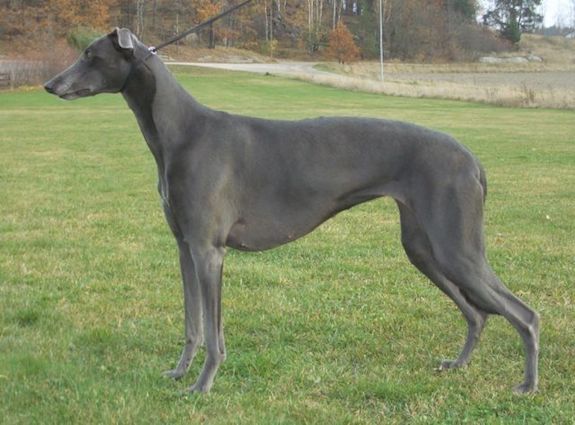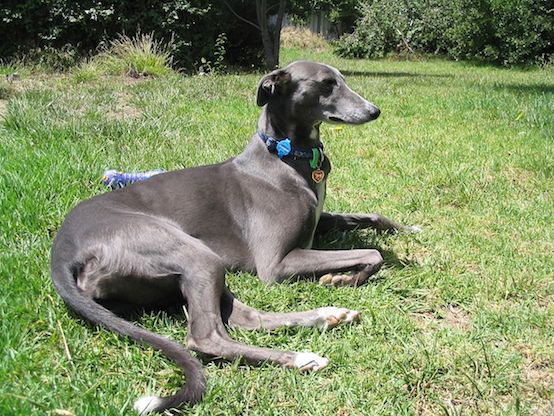
The AKC breed standard for the Greyhound indicates that color in this breed is “immaterial,” but all Greyhounds are one of two basic colors as determined by gene pairs at the A location, black or sable red. That said, when registering a Greyhound with the AKC, there are thirty-nine colors and four markings from which to choose, and gray is not one of them.
Grey colored Greyhounds are actually rare, and are not referred to as gray, but as “blue.” Blue is a dilute of the color black, and in order for a Greyhound to have a blue coat or any variation of blue, the recessive gene must be passed down by both parents. This unique gene makes blue Greyhounds a rarity, the color ranging from a pale misty blue to a deep blue (grey) almost black color. Most blues will also have bluish rather than black colored nose leather.

Among some breeders, Greyhounds that normally identify as blue, blue brindle or blue fawn are sometimes grouped into a category called “Blue Variant” to help determine color inheritance when considering future matings. As an aside, we came across a comment on a Greyhound forum which states that blues are “the blondes of the Greyhound world.” Another added that blues are “quirky.” Still a third poster replied, “I have a blue brindle, and I can attest to the fact that she is a princess who believes the entire world is there only for her convenience (except for the parts that scare her, and they are to be ignored or run away from).
Sounds like a fun dog to know. Just saying.
If interesting coat colors in the Greyhound interest you, you’ll want to read this about Snowflake Greyhounds.
Our top image is of a blue Greyhound bitch from Sweden named Blue-Dream’s Waltzing Mathilda owned by Annki Oscarsson. We found Blue Dream’s image on a site which didn’t indicate copyright restrictions on photographs, so we share it here in the interest of education and with the understanding that we’re not infringing. The middle photo comes from Wikimedia Commons. She is an Australian retired racing blue Greyhound named Tillee and is seen here relaxing.

Blues or their varieties are not that rare here in Australia. I’ve bred 20 pups and out of those 20 were 4 blue brindles, 2 white and blue fawns and 2 white and blue brindles. These were ANKC pups. I don’t consider them rare in the racing dogs either. Not common but not rare.
Thanks for the updated information, Anne. Given the sources we found – most of them American – perhaps the “rareness” is tied to the country and the gene pool of the breed in this country?
Why do you breed dogs when there a literally MILLIONS just in America alone that are killed yearly in animal shelters? They only get less than a handful of days to live (some less than 2 days), just because they are homeless and unloved by sorry humans that are too selfish to de-sex their “pets.” They usually wind up dumping them at animal “shelters” for stupid reasons like “moving, and can’t take dog or cat with me,” to “landlord won’t allow pets,” or “just had a baby.” 🙄 I guess you are more concerned with making a sale than the life of the dog you bring into this cruel world.
We can’t speak for Anne, but we’d like to point out the insanity of importing hundreds of thousands of dogs into the US when some point believe there is an “overpopulation” problem. Heritage breeders aren’t the problem here. Preservationist breeders who health test, properly socialize their puppies and carefully vet prospective owners are creating the next generation of sound, happy dogs of a breed that was created by cultures or individuals for a reason, and when you lose these dogs, you lose the legacy of these people. Too, many wonderful owners need predictability in their family dog, and we don’t fault them for working with responsible breeders or the rescue committees of breed clubs.
Both blue Whippets and blue Greyhounds are much more common in the UK and Ireland (and Australia). For whatever reason with the gene pool in the USA the color is less common in both (but definitely can be found) breeds in the USA. Blue Whippets have traditionally been frowned upon in the show community, even though the color is perfectly acceptable according to the breed standard. That’s slowly changing, but you still won’t see them as much as their brindle and fawn counterparts.
Very interesting comment, Whippet fan, thanks for leaving it. One wonders if “popular sire” has anything to do with the greater frequency of blues elsewhere?
Back about 47 years ago, when racing Greyhounds was still popular in America, my boyfriend and I happened to see an article in the newspaper about someone adopting a retired racing Greyhound from a racetrack. The article mentioned the way the Greyhounds were euthanized if they failed to win races. I decided I wanted to rescue a racing Greyhound, so we headed to the racetrack in Memphis, Tennessee to see if we could get my Greyhound! We succeeded in being able to get a beautiful blue fawn male named PECOS! He had the prettiest eyes! I went on to rescue several more over the years. One was a small little black female named Mouse, and a large black male named Whiz. One brindle male I rescued name Duggan loved to jump the fence! He got out one night and ran around the neighborhood until he was about 3 miles away from home. I put an ad in the newspaper’s “Lost & Found,” and got a call that evening. A lady had a Doberman that loved to jump, and she told me her fence was 8 feet high, so my Greyhound should be secure in her back yard… Boy was she shocked the next morning when she discovered that my Greyhound had cleared her 8 foot high fence! But luckily I found him right down the road! He jumped in my car the minute I stopped and opened the door!!